EXQUISITE FLORAL TOP
This is yet another lovely pattern off a
Pinterest board that had a neat convenient chart along with it. I loved that it looks like a set of
complicated motifs, but it is a neat continuous pattern.
Thank you for joining me.
In case you have just joined me, know that you can access all of my earlier creations by checking under ‘categories’ on the right hand side of this blog under “Labels”. Then, for your convenience, follow me here or on Facebook, You Tube, Pinterest, Twitter or Instagram.
Check out all my social media handles at the bottom of this blog
Oh, and may I add that the fastest way to find any of my blogs is via Pinterest.
All my blogs can be printed. Find the printer friendly (green) link on the right side of this blog. You can also hit Control P (or Command P for Mac) on your keyboard, and the blog will go directly to the connected printer.
Remember that you only print if absolutely essential. Save paper – Save Our Earth.
Do remember to add my blog URL when you make and show off your creation.
Just copy the link on the search bar above - that's the blog URL.
To purchase this or similar yarn online, click here to buy your yarns online via Amazon. While you will still pay the same, I may get paid by Amazon as well.
This is a free blog - so do pay it forward for me. Cheers.
Materials used : Today I’ve used our lovely Indian Red rose knitting cotton yarn,
with a 3 mm crochet hook . Same pattern, different yarn and you'll have a totally different end product.. what a difference a yarn makes!
This yarn is not specific for the pattern.
Use any yarn with a suitable hook to make this to any size.
For Indians : You can use Anchor knitting cotton as well
For Non-Indians : I have used a regular knitting cotton that technically uses a 2 – 2.5 mm crochet hook (recommended). I use a larger hook as I like the extra stretch it affords the end product. Among the international yarns I have used in this thickness, I’d suggest Aunt Lydia Cotton 10, Aunt Lydia Bamboo-Viscose 10, DMC Petra, Sullivans knitting cotton (Australia), Milford Soft, Hilaza Rustica Eclat , Alize cotton yarn and Alize bamboo yarn.
Skill level : Intermediate to Advanced.
Lots and lots of photographs and instructions.. so do come along and we'll work on this together
Abbreviations used : (Using U.S terminology)
ch : chain ch-sp
: chain space
sp : space rep
: Repeat
st(s) : Stitch(es) lp(s) : Loop(s)
sl-st : Slip stitch
yo : Yarn over hk : Hook
fsc : Foundation single crochet
sc : Single crochet
dc : Double crochet
dc 2-tog : Double Crochet 2-together
dc 3-tog : Double Crochet 3-together
Stitches used :
Instructions :
Please note that I start all my rows with a ch 1, turning chain for ease.
Please check the top of this blog for easy video tutorials on all stitches used in today's pattern. For your convenience there video tutorials through the blog too
Please read through all my notes before you pick up your hook, so you know just where we're heading in our pattern.
In my patterns I work with the principle of stitch count and body measurement.
This means that you need to work the stitch count in pattern, till you get the measurement (length and/or width) that you need for your project.
As I work on this pattern, I’ve written down my notes that I share with you.
Quick analysis of what we’re going
to do here today.
I have
decided to start this top from the waist and then work up towards the neck and
shoulders. I am going to start with a
foundation double crochet (fdc) and then work the lovely floral yoke pattern.
When done, we will come back to this
foundation row and work a little floral pattern at the base of the waist.
So when calculating the length,
ensure that you keep the base / border floral pattern bit in mind. This becomes important only if you are strict about the length of your top. In this case, you would need to work a swatch to gauge how many inches make up this floral pattern and then work your top length keeping this in mind.
In all my tops, I first decide what length I want the top. If it is going all the ay down to my hips, then I need the bust, waist and hip measurements. I will then start with the largest measure. As we generally work two halves for our top (one back and one front), we always start with half the round measurement using the largest measure of our body.
Today's pattern is pretty simple. We start at the base and work our way up to the armholes, working in dc all the way. You can choose to work in dc , hdc or sc. We then work the floral "V" pattern for the neckline. Finally we go back down to the starting row and work a floral border to finish.
As I have worked. the body of my work in dc, I started with fdc.
In case you want to work the body in sc , start with fsc.
In case you want to work the body in hdc , start with fhdc.
Foundation half double crochet (fhdc) : This is an easy way to start a row of hdc without the starting chain row.
Our stitch count is in multiples of 6 + 1
Foundation double crochet (fdc) : This is a unique way of starting a project directly with a row of double crochet stitches. Here is an easy video tutorial https://youtu.be/hjNUYVvyU9k
Start with fdc needed for half the round waist / bust / hip measure. Turn
(whichever is the higher measure).
Double Crochet : dc : yo, insert hk into st ; yo (3 lps on hk);
[yo, draw through 2 lps] twice. One dc made.
Chainless start for Double Crochet : I dislike the ch-2 / ch – 3 start, and this is what I do to start my row of dc.
Row 1 : dc in the 1st fdc and in each fdc till the
end. Turn.
Row 2 : dc in the 1st dc and in each dc till the
end. Turn.
Rep Row 2 till your project is just
under the armhole.
Calculations : Now here’s what I suggest.
Do a quick swatch of the pattern for the neckline to see how many inches
make up one pattern repeat.
This way you
can then decide where you need to start your pattern and how far under the
armhole you will work.
Once I’d worked this out,
here’s what I did.
I worked out which
was the centre dc of that last row.
I
then skipped 2 dc on either side of that centre dc, and placed two new
markers. Take off that centre marker
now.
Pattern Row 1 : dc in the 1st dc and each dc till the 1st
marker ;
ch 3, sk next 2 dc, sc in the next dc ;
ch 3, sk next 2 dc, dc in the
next marked dc,
and in each dc till end.
Turn.
Move markers one row up.
We are now going to start on
our first flower.
Now each petal of our
flower is a dc 3-tog.
We will work till
that 1st marker, or the dc before that ch-3 sp.
In this row, we will work on
the first four petals of our flower, which will be in the (to).
Double crochet 2-tog : dc 2-tog : [yo, insert hk in st or ch-sp, yo and pull up a lp ; yo and draw through 2 lps] 2 times (3 lps on hk) ;
{yo, draw through 2 lps on hk} 2 times. One dc 2-tog made.
Sometimes we work the dc 2-tog in the same stitch, to use as a decorative stitch.
Pattern Row 2 : dc in the 1st dc and each dc till the dc before
ch-3 sp ;
ch 3, turn and dc 2-tog in the earlier dc ;
[dc 3-tog in the
next ch-3 sp] ;
sk next sc, rep [to] once ;
ch 3, turn and dc 2-tog onto
the top of the earlier dc 3-tog;
dc in the next marked dc,
and in each dc
till end. Turn.
Move markers one row up.
In the following row we will
start with our next set of flowers.
So
we will first move our markers five dc on either side and place the markers in the next dc.
Pattern Row 3 : dc in the 1st dc and each dc till the 1st
marker ;
(ch 3, sk next 2 dc, sc in the next dc ;
ch 3, sk next 2 dc, dc in the
next dc) ;
[ch 1, dc 3-tog in the next dc 3-tog] ;
{ch 3, dc 3-tog in the next
dc 3-tog} ;
ch 1, dc in the next dc ;
rep (to) once ;
dc in each dc till
end. Turn.
Move markers one row up.
In this row, we will work on
the first four petals of our flower for the next set, which will be in the
(to).
Pattern Row 4 : dc in the 1st dc and each dc till the dc before
ch-3 sp ;
{ (ch 3, turn and dc 2-tog in the earlier dc ;
[dc 3-tog in
the next ch-3 sp] ;
sk next sc, rep [to] once ;
ch 3, turn and dc 2-tog
onto the top of the earlier dc 3-tog) ;
dc in the next marked dc} ;
ch 5, sk
next two ch-1 sps and ch-3 sp, dc in the next dc ;
rep {to} once ;
and in each
dc till end. Turn.
Move markers one row up.
In this row, we will work on
the first four petals of our flower for the next set, which will be in the
(to).
Pattern Row 5 : dc in the 1st dc and each dc till the 1st
marker ;
(ch 3, sk next 2 dc, sc in the next dc ;
ch 3, sk next 2 dc, dc in the
next dc) ;
[ch 1, dc 3-tog in the next dc 3-tog] ;
{ch 3, dc 3-tog in the next
dc 3-tog} ;
ch 1, dc in the next dc ;
ch 3, sc in the next ch-5 sp ;
ch 3, dc in the next dc ;
rep [to] once ;
rep (to) once ;
dc in each dc
till end. Turn.
This completes one pattern
repeat.
Now do you see how we are
growing our pattern sideways, adding one flower per row, and neatly making a
“V’ shaped front floral yoke every alternate row.
So continue increasing it
sideways till you reach the side of the armhole.
Rep Rows 4 & 5 till your
pattern reaches the armhole.
Now you need to remember that
we need to decrease and shape the armhole.
So while our pattern continues
in the centre, I’m just going to write out the armhole decrease as well.
Armhole decrease Row
1 : Sl-st into the 1st 5 dc ;
dc in the next dc and
each dc till we reach the centre pattern section ;
work the pattern section as
per the instructions above ;
dc in each dc after pattern till the last 5 dc, sk
last 5 dc. Turn.
Armhole decrease Row
2 : dc 2-tog over the 1st 2 dc
and each dc till the
centre pattern section ;
work the pattern section as per the instructions above
;
dc in each dc after pattern till the last 2 dc,
dc 2-tog over the last 2
dc. Turn.
Armhole Row 3 : dc in the 1st dc and each dc till the centre pattern
section ;
work the pattern section as per the instructions above ;
dc in each
dc after pattern till the last dc. Turn.
We will now continue without
further armhole decrease and with just the centre pattern growing with each
alternate row.
Rep the pattern row and with a straight armhole side, till you reach the
neckline level.
For the neck, what I’ve
done is mark the centre of the top for the neckline and then worked the pattern
only till that point, and then turn.
We will then work only one side
of our top to the shoulder, and then come back to work the other side of the
front.
There is one pattern here for
the back, and another pattern for the base of the top. The two patterns are
similar, but they give a different result.
Look through both to decide which one you wish to use where.
BACK
The back for this top starts in
the same way as the front.
You will work
the plain dc’s all the way past the armhole section and then we will only work
the pattern just off the shaping for the armhole.
So once the plain dc bit is
done, let’s work the pattern.
Pattern Row 1 : dc in the 1st dc ;
(ch 3, sk next 2 dc, dc
3-tog in the next dc ;
ch 3, dc 3-tog in the same dc ;
ch 3, sk next 2
dc, dc in the next dc) ;
[ch 3, sk next 2 dc, sc in the next dc ;
ch 3, sk next
2 dc, dc in the next dc] ;
*rep (to) once ;
rep [to] once* ;
rep *to* till end,
ending with a (to). Turn.
In this row, we will work on
the first four petals of our flower for the next set, which will be in the
(to).
Pattern Row 2 : dc in the 1st dc ;
*(ch 3, sk next ch-3 sp, sc in
the next ch-3 sp ;
ch 3, sk next ch-3 sp, dc in the next dc) ;
{ch 3, turn
and dc 2-tog in the earlier dc ;
[dc 3-tog in the next ch-3 sp] ;
sk next sc,
rep [to] once ;
ch 3, turn and dc 2-tog onto the top of the earlier dc
3-tog ;
dc in the next dc}* ;
rep *to* till end ;
ending with a rep (to). Turn.
Pattern Row 3 : dc in the 1st dc ;
*(ch 3, sc in the next sc ; ch
3, dc in the next dc) ;
{[ch 1, dc 3-tog in the next dc 3-tog] ;
ch 3, dc 3-tog
in the same dc 3-tog ; ch 1, dc in the next dc}* ;
rep *to* till end ;
ending with a rep (to). Turn.
Pattern Row 4 : dc in the 1st dc ;
*{ch 3, turn and dc
2-tog in the earlier dc ;
[dc 3-tog in the next ch-3 sp] ;
sk next sc, rep [to]
once ;
ch 3, turn and dc 2-tog onto the top of the earlier dc 3-tog ;
dc
in the next dc} ;
(ch 3, sk next ch-1 sp, sc in the next ch-3 sp ;
ch 3, sk
next ch-1 sp, dc in the next dc)* ;
rep *to* till end ;
ending with a rep
(to). Turn.
Pattern Row 5 : dc in the 1st dc ;
*{[ch 1, dc 3-tog in the next
dc 3-tog] ;
ch 3, dc 3-tog in the same dc 3-tog ;
ch 1, dc in the next
dc} ;
(ch 3, sc in the next sc ; ch 3, dc in the next dc)* ;
rep *to* till end
;
ending with a rep (to). Turn.
LOWER BORDER OF TOP :
For this lower part of top,
we’re working in a round, so join the sides first and then follow pattern
instructions.
Our pattern repeat is at 6.
Pattern Round 1 : dc in the 1st 5 dc ;
(ch 1, sk next 2 dc, dc
3-tog in the next dc ;
ch 3, dc 3-tog in the same dc ; ch 1, sk next 2
dc, dc in the next dc) ;
[dc in the next 4 dc] ;
*rep (to) once ;
rep [to]
once* ;
rep *to* till end,
and join with a sl-st to the 1st st.
Pattern Round 2 : sl-st into the 1st dc ; dc in the same 1st
dc ;
dc in the next 2 dc ;
*sk next dc,
dc 3-tog in the next dc 3-tog ;
ch 3, sc in the next ch-3 sp ;
ch 3, sk next
dc, dc in the next 3 dc* ;
rep *to* till end,
and join with a sl-st to the 1st
st.
In this row, we will work on
the first four petals of our flower for the next set, which will be in the
(to).
Pattern Round 3 : dc in the 1st dc 3-tog ;
*(ch 3, sk next dc, sc
in the next dc ;
ch 3, sk next dc, dc in the next dc 3-tog) ;
{ch 3, turn
and dc 2-tog in the earlier dc ;
[dc 3-tog in the next ch-3 sp] ;
sk next sc,
rep [to] once ;
ch 3, turn and dc 2-tog onto the top of the earlier dc
3-tog ;
dc in the next dc 3-tog}*;
rep *to* till end.
Join with a sl-st to the 1st
st.
Pattern Round 4 : dc in the 1st dc ;
*(ch 3, sc in the next sc ; ch
3, dc in the next dc) ;
{[ch 1, dc 3-tog in the next dc 3-tog] ;
ch 3, dc 3-tog
in the same dc 3-tog ;
ch 1, dc in the next dc}* ;
rep *to* till
end.
Join with a sl-st to the 1st
dc.
I’ve decided to work a beaded
row.
Optional last round : sc in the 1st st ;
*ch 3, sl-st into the next sc
;
ADD BEAD ; sl-st into the same sc* ;
rep *to* all around ;
ADD BEAD,
sl-st into the 1st st.
Note : You could decide to do the border round that we’ve done
around the neckline and armhole instead of the Optional last round above as
well.
So let your creativity flow and
have fun.
Fasten off and weave in ends.
Finishing :
For a neat border around the
neckline and armhole, here’s what I’ve done.
I’ve run a round of sc first, and then a little shelled border all
around.
You could work work a reverse sc / crab stitch border too
Attach your yarn at the
shoulder on either side, and we’re working a round of ch-3 sps all around. Now around certain parts of the neckline and
armhole, it may be difficult to see how you get the ch-3 sps, so just wing it
and ensure that you get an even sized set of spaces.
The number of spaces do not matter, so go
ahead and have fun.
Round 1 : sc in the 1st st ;
(ch 3, sc in the horizontal
bar end of the next st) ;
rep (to) all around
and join with a sl-st to the 1st
st.
Round 2 : ch 3 + 2 dc all in the same 1st sc ; sc in the 1st
ch-3 sp ;
(ch 3 + 2 dc all in the next sc ; sc in the next ch-3 sp) ;
* sl-st
into the next sc ;
rep (to) once* ;
rep *to* all the way around,
and join with
a sl-st to the 1st sc.
Note : I’ve decided to use a pearl bead in this round.
So, I’ve done the ch 3 + 3 dc in the sc, and
then added the bead, and then sc in the ch-3 sp. See if this works for you too.
Fasten off and weave in
ends. Give yourself a big pat on the
back as this one has really been a great project – but totally worth it, I’m
sure you’ll agree.
And that’s done.. yet another
project brilliantly executed !
Enjoyed this ?? I sure did.. Come back right here for more freebie patterns
Remember to share this blog post when you share your photos with me on Facebook. I’d love to feature your photos on my FB page. Cheers.
If you're visiting me here for the first time, and have liked the experience, do add me to your mailing list (for your convenience) , and all my future free patterns will come straight to your mail box.
I’d appreciate if you could credit my blog (and link the original pattern link) when you make your own creation. Thanks.
Have a great day and see you soon.
I have a few tops already made, and just in case you want a dekho at those
free patterns … here you go
and a doll’s top..
and some bolero/jacket/vests that will look grand on a top..
I have a few girls dresses, and just in case you want a dekho at those free patterns … here you go
For cute hair embellishments and motifs check the links below.
..and some belts..
and here are a few skirt patterns that you can use your belt for..



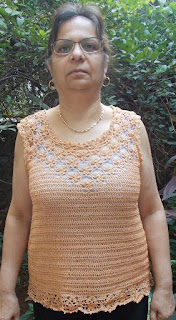






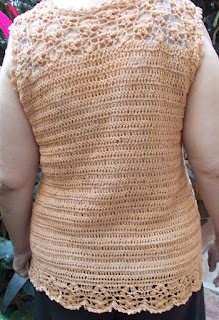




















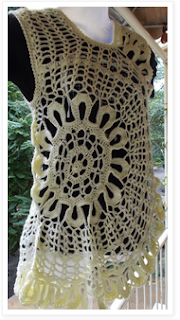
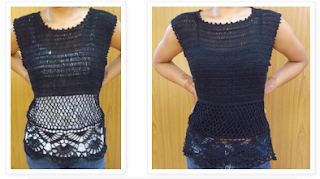



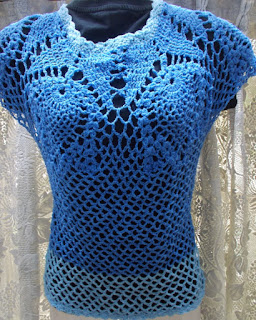

Hello Shyama, how much akc did you use and what's the finished size that you got?
ReplyDeleteHi Vimala, I used about 350 - 400 gms of Red Rose and this was a XXL - XXXL size
DeleteHi do you have videos of your pattetns
Delete